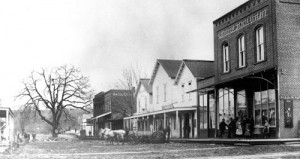Being raised in the relatively prosperous period of post-war America, many of us were lulled into a false sense of stability.
But it was a stability of limited choices.
Society as a whole seemed to take on a bland veneer.
This was visible everywhere in society. Beautiful old Victorian buildings in downtown Salem and elsewhere, were covered over with panels that gave them this monolithic block appearance. As if too much detail is a bad thing.
Society likewise “encouraged” conformity in human behavior. Those who did not conform, either for social or political reasons, often found themselves ostracized from society. Or worse.
In spite of these facts, the glory years of the 1950s and 1960s are often touted by some in our community as a goal to return to, like some Andy Griffith delusion.
“We’re just 50 miles and 50 years away from Portland…” the catch-phrase goes.
But do we really want to go back to an era, known for loyalty oaths, institutionalized racial bigotry and the beginning of centralized systems of production and distribution that truly killed many small town economies?
But in the long run, “want” really has nothing to do with it.
What we as individuals “want” is irrelevant when market forces are guiding the way.
And that guidance is primarily due to the ever-increasing cost of fuel. It is forcing communities to face the reality of change.
A change back to a time when the streets in town were for people, with vehicles used to support people. Still, some folks cling to the civic view that streets and towns should be designed, built and maintained around these mechanical devices.
Any move to restrict vehicular traffic, is somehow in violation to this “Mayberry Delusion,” that says all would be rosy when people can once again plug parking meters with copper-coated zinc disks so that their mechanical devices can sit in the street for another 12 minutes.
The simple fact is that we can’t go back 50 years or even 150 years.
We can only move forward. It’s called “progress.”
But the concept and very word “progressive” has become suspect, like the term “liberal.”
This is so entrenched in our society, that those who desperately try to hold on to a changing reality often go to extreme, bizarre, and often quite effective, means to maintain the status quo.
Or even to restore it to some long-vanished ideal.
But today’s society, with today’s problems as well as today’s opportunities, is completely unique to today.
Not to the 1950s or even to the 1890s. We need to address today’s reality with solutions from today. Drawn of course, from lessons learned from yesteryear.
A big lesson I think we should learn from our past is that streets are for people.
Mechanical vehicles are a permanent part of our society, and will remain so. But the numbers and size of them will decrease, due to market forces.
These trends have been at work in Silverton for years, as evidenced by the continued vibrancy of a downtown that attempts to cater to people.
Murals, walking tours, and foot bridges are market indicators. The pedestrianization of 280 feet of East Main Street follows this existing trend in our community, towards a town square custom-fit for humans in mind.
Would this spell economic doom? Turn Silverton into a ghost town because people would have to walk an extra 140 feet? Allowing only the “idlers and vagabonds” to ply their trades?
The data certainly doesn’t indicate such dire results. Actually, it says just the opposite: These sorts of projects are beneficial both economically and civically. Especially in today’s changing world.
Which makes perfect sense, when you realize that these designs and plans were put forward by professional men and women that our city has hired for this purpose.
Our city planner and his staff have chosen as a career, the very thing we hired them for. They know the trends, have done the research and have seen other similar projects, and proposed this project based upon that experience.
However, I would not go to the city planner for a delicious home-style restaurant meal. Or to open a checking account. Or to have my clothing altered.
I would go to those merchants or service providers who have made that their line of work and are skilled in it.
Why should it be different for city planning?
Yet instead of trusting trained experts who are proposing a positive endeavor, many would rather listen to a few decidedly non-experts predicting a dire negative outcome, based not on experience or facts, but on emotion and conjecture.
Ever since the “golden years” of the fifties and sixties we have seen a steady erosion of local goods and services.
Because it use to be cheaper to ship stuff in from vast distances, the local services and suppliers could not compete and went out of business.
This trend is reversing.
Slowly at first, but it is picking up steam as time goes on.
Maybe not in time to restore Town Square now. But like an acorn, this idea, has been planted. Unlike the acorn, it will grow quicker than an oak.
This idea that people can once again walk across, through, down and on East Main Street, like they owned the place, will again be popular.
Some may see this as a “battle to be won,” but I don’t. The fact that this discussion is even happening is a clear indicator of this change.
The idea of catering to cars, while still deeply entrenched in our society, will eventually pass. These views and concepts will eventually be viewed in the context of a future society.
One that no longer has vast reserves of cheap easy energy, because an earlier generation decided that it was only theirs to use.
Gus Frederick’s background includes working as a graphic artist, animationist, filmmaker and photographer. He serves on the Silverton Planning Commission.
